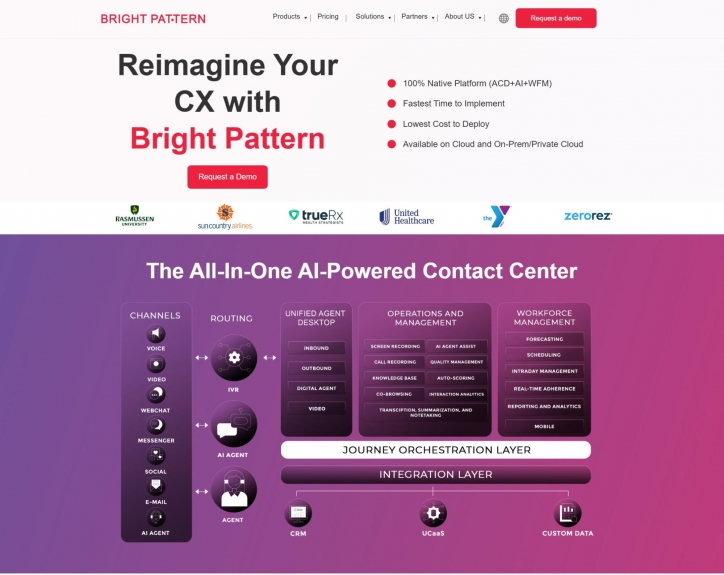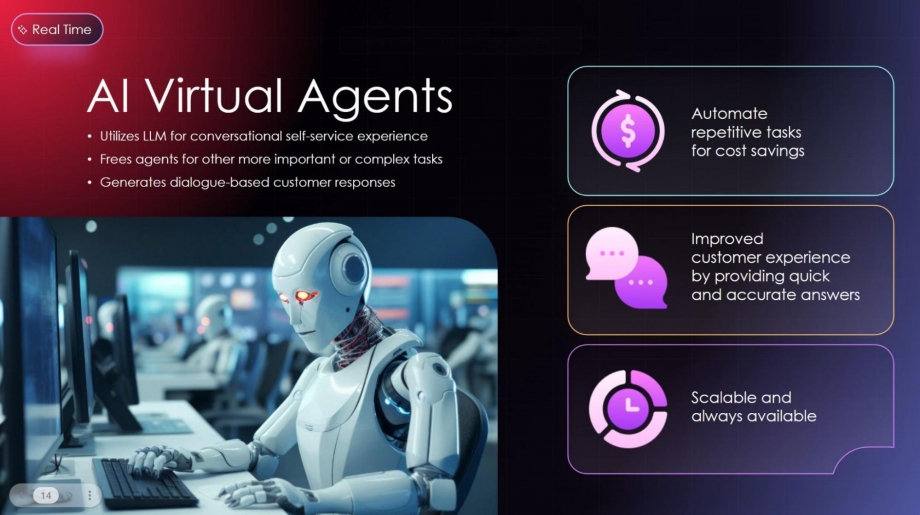The Rise of AI in Call Centers
Customer experience (CX) has become one of the most important factors in driving business success. Modern customers expect personalized, quick, and consistent support across all channels whether it’s through phone calls, live chat, email, or social media. That’s why businesses are turning to AI Solutions to meet these growing expectations and deliver exceptional service every time.
The AI-powered platform uses advanced automation, natural language understanding, and real-time insights to help companies cut costs, improve response times, and elevate customer satisfaction. By learning from every interaction, it transforms call centers from cost centers into valuable hubs of engagement that strengthen customer relationships and loyalty.
This guide will show you how AI Call Center Solutions can make your operations smarter, faster, and more connected, creating seamless experiences for both your team and your customers.
Top 10 AI Call Center Solutions for Modern Businesses
Great brands stand out by how well they treat their customers. Modern call centers aren’t just about answering questions anymore they’re about creating smooth, personalized, and proactive experiences.
AI in call centers makes this possible. From virtual agents to real-time insights, AI helps businesses solve problems faster, keep customers happy, and work more efficiently. Here are the top 10 AI call center solutions transforming customer service today.
1. Bright Pattern – The Complete AI-Powered CX Platform

Bright Pattern AI Call Center Solutions lead the way in modern customer engagement. Designed for true omnichannel communication, Bright Pattern integrates AI, automation, and human empathy into one unified platform. Its Conversational IVR understands natural language, while AI-driven routing ensures customers reach the best agent every time. Real-time sentiment analysis and predictive insights help agents deliver more personalized, emotionally intelligent interactions.
Why Businesses Love It: Bright Pattern combines simplicity and scalability—making enterprise-grade AI accessible to companies of all sizes while driving faster response times, better agent performance, and exceptional customer satisfaction.
2. Five9 Intelligent CX Platform
Five9’s AI capabilities bring automation and intelligence to every stage of customer interaction. Its virtual agents handle routine tasks, while AI insights help human agents make smarter decisions and create meaningful connections.
Best For: Businesses seeking cloud-based scalability with a strong AI automation backbone.
3. NICE CXone
NICE CXone uses predictive analytics and machine learning to enhance contact center efficiency. Its AI-driven quality management tools automatically evaluate interactions, ensuring compliance and consistent service quality.
Best For: Large organizations focused on analytics, compliance, and performance optimization.
4. Genesys Cloud AI
Genesys delivers AI-powered orchestration across all customer touchpoints. Its AI can predict customer intent, optimize routing, and assist agents with real-time suggestions—helping organizations scale exceptional service without losing the human touch.
Best For: Enterprises looking for deep integrations and predictive customer engagement.
5. Talkdesk AI
Talkdesk infuses AI into every part of the customer journey, from automated self-service to agent coaching. Its Virtual Agent and Auto QA features help reduce costs while improving accuracy and experience.
Best For: Fast-growing businesses aiming to modernize support with data-driven decision-making.
6. Zendesk AI
Zendesk’s AI assistant helps streamline customer interactions across chat, email, and social. It learns from every interaction to provide better, faster responses and reduces ticket handling time for agents.
Best For: Businesses already using Zendesk’s customer service suite looking to enhance efficiency with AI.
7. Amazon Connect
Amazon Connect leverages AWS machine learning to power intelligent routing, real-time transcription, and sentiment analysis. It’s easy to integrate and ideal for enterprises seeking scalable, cloud-native AI solutions.
Best For: Tech-savvy organizations that want customizable AI solutions built on AWS infrastructure.
8. Salesforce Service Cloud Einstein
Einstein AI helps automate service workflows and provides agents with predictive recommendations based on CRM data. Its deep learning capabilities make customer interactions more insightful and efficient.
Best For: Businesses invested in the Salesforce ecosystem wanting unified AI-powered CX.
9. 8x8 Contact Center AI
8x8 combines AI-driven insights with omnichannel communication tools, helping businesses manage customer conversations across voice, chat, and digital channels seamlessly.
Best For: Mid-sized organizations looking for flexibility and integrated communication features.
10. Avaya Experience Platform
Avaya’s AI and automation tools bring intelligence to every call, message, and chat. Its analytics uncover trends, improve agent training, and ensure consistent customer service quality.
Best For: Established enterprises transitioning to digital-first customer engagement.
Ways AI in Call Centers Is Transforming Modern Businesses
Speed, personalization, and convenience are everything. Businesses can no longer rely solely on traditional call centers to deliver consistent, high-quality service. This is where AI-powered call center solutions, like Bright Pattern, are changing the game—bringing automation, intelligence, and empathy together to create a smarter customer experience.
1. AI-Powered Virtual Agents and Chatbots
A common way Bright Pattern AI Call Center Solutions use AI is through virtual agents and intelligent chatbots. These tools handle everyday customer questions, provide instant responses, and assist with common tasks like password resets, order tracking, or answering FAQs—all without the need for human intervention.
Unlike traditional IVR systems, Bright Pattern’s AI chatbots understand natural language and respond in a conversational, human-like way. They’re available 24/7, ensuring customers always receive quick, accurate assistance—no waiting on hold or being transferred between departments. For modern businesses, that means happier customers, reduced costs, and more efficient operations.
Example: Using Bright Pattern’s AI chatbots, telecom companies can automate routine billing questions, freeing up live agents to focus on complex issues like technical troubleshooting and customer retention.
Benefits:
- Quickly resolve common questions without making customers wait
- Cut down on long hold times in your call center
- Easily scale support as your business grows—no extra staff needed

2. Intelligent Call Routing
Connecting customers with the right person has always been a struggle for service teams. Traditional routing often sends callers to the wrong department or agent, leaving everyone frustrated. With AI in call centers, that problem disappears; Calls are intelligently directed based on the customer’s history, mood, and the agent’s expertise, making each interaction faster, smoother, and more effective.
Bright Pattern’s AI-powered call routing uses advanced machine learning algorithms to analyze real-time data and automatically connect customers to the most suitable agent. This improves first-call resolution rates, reduces handling time, and creates a more personalized customer experience.
Example: Using Bright Pattern’s intelligent routing, a bank can identify when a customer has previously shown interest in mortgage loans. Instead of starting from scratch, the system instantly connects the caller to a financial advisor specializing in home financing—saving time and improving satisfaction.
Benefits:
- Fewer call transfers and escalations
- A smoother, more personalized experience for customers
- Agents are able to get more done in less time and work more smoothly.
3. Sentiment Analysis for Customer Interactions
Another powerful application of AI in call centers is sentiment analysis, and Bright Pattern AI Call Center Solutions excel in this area. The platform uses advanced AI to evaluate customer tone, language, and emotions in real time—helping determine whether a customer is satisfied, frustrated, or confused.
With this insight, Bright Pattern enables call centers to:
- Alert supervisors when a conversation starts to go off track.
- Give agents real-time suggestions to calm tense situations.
- Track sentiment trends over time to improve overall CX strategies.
Example: Using Bright Pattern’s AI Sentiment Analysis, an e-commerce company can detect when a customer sounds upset during a return request. The system instantly flags the case and routes it to a senior agent empowered to offer a discount or loyalty reward.
Benefits:
- Better understanding of customer emotions
- Real-time coaching for agents
- Data-driven insights into customer satisfaction
4. Automated Quality Assurance
Bright Pattern revolutionizes quality monitoring with AI-driven Automated Quality Assurance. Instead of relying on manual call reviews, Bright Pattern’s AI analyzes every single interaction to ensure agents follow scripts, maintain compliance, and deliver consistent service.
Example: A health insurance provider using Bright Pattern AI Quality Assurance can automatically verify that agents follow privacy guidelines and compliance rules during every call.
Benefits:
- 100% call coverage and visibility
- Faster compliance risk detection
- Actionable feedback for agent performance improvement
5. Predictive Analytics for Customer Needs
Bright Pattern AI Call Center Solutions use predictive analytics to anticipate what customers need—before they even ask. By analyzing historical data and behavior patterns, Bright Pattern helps companies proactively offer solutions that prevent frustration and increase retention.
Example: A subscription-based business can use Bright Pattern Predictive Analytics to identify customers likely to cancel, enabling the support team to reach out early with personalized offers or guidance.
Benefits:
- Anticipate customer needs
- Boost loyalty and retention
- Create proactive, not reactive, service
6. Real-Time Agent Assistance
With Bright Pattern’s Real-Time Agent Assist, AI becomes a powerful sidekick for every support representative. The system delivers live suggestions, relevant knowledge base articles, and automatic note-taking during interactions—helping agents stay focused on listening and problem-solving.
Example: During a tech support call, Bright Pattern AI instantly identifies the issue and guides the agent through the correct troubleshooting steps, reducing call time and improving accuracy.
Benefits:
- Boosted productivity and consistency
- Reduced training time for new agents
- Smarter, faster resolutions
7. Speech Recognition and Voice Analytics
Bright Pattern AI Voice Analytics goes beyond simple transcription—it understands context, intent, and emotion. The platform listens to calls, identifies key topics, flags compliance risks, and provides valuable insights for quality and training improvements.
Example: A travel agency using Bright Pattern Voice Analytics can quickly spot spikes in calls about flight delays, prompting immediate updates to FAQs and proactive communication with customers.
Benefits:
- Accurate call transcripts for compliance
- Deeper insights into customer trends
- Smarter data for business decisions
8. Smarter Scheduling (Workforce Optimization)
Bright Pattern’s AI Workforce Management optimizes schedules with precision. By forecasting call volumes and customer demand, it ensures the right number of agents are always available—reducing overtime costs and preventing burnout.
Example: A retail brand can use Bright Pattern AI Scheduling during peak holiday seasons to predict traffic and ensure full coverage without overspending.
Benefits:
- Optimized staffing and lower costs
- Improved agent satisfaction
- Balanced workloads across teams
9. Fraud Detection and Security
Security and trust are critical in today’s call centers, and Bright Pattern AI provides advanced fraud detection by monitoring voice patterns, identifying unusual activity, and stopping threats in real time.
Example: A bank using Bright Pattern AI Security can automatically verify if a caller’s voice doesn’t match their identity profile and trigger additional authentication steps.
Benefits:
- Enhanced customer and business protection
- Reduced financial fraud risks
- Greater customer confidence
10. Omnichannel Customer Engagement
Bright Pattern AI Call Center Solutions bring every customer channel—voice, chat, email, SMS, and social—into a single seamless platform. This unified approach ensures customers never have to repeat themselves, no matter where the conversation starts or ends.
Example: A retail brand can use Bright Pattern Omnichannel AI to sync conversations from Facebook Messenger, live chat, and email, giving agents full visibility into customer history for more personalized service.
Benefits:
- Seamless, consistent customer experiences
- Stronger brand loyalty and trust
- Centralized visibility across all channels
Final Thoughts
AI is transforming customer service. With tools like chatbots and predictive insights, businesses can now respond to customers more quickly while still making the experience feel personal. It all comes down to finding the right balance between technology and people. When companies get this right, they not only save money but also build customer relationships that last.
Platforms like Bright Pattern make it simple by bringing all conversations—whether by phone, text, or social media—together in one place. This helps businesses stay ahead and get ready for a future where customers are truly in charge.






